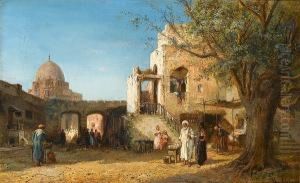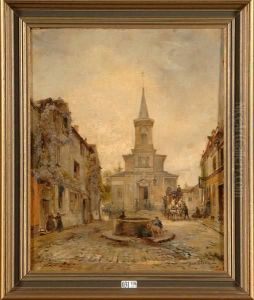Paul Constantin D. Tetar Van Elven Paintings
Paul Constantin Dominique Tetar van Elven, born on March 1, 1823, in Delft, the Netherlands, was a Dutch painter and art educator known for his historical scenes, portraits, and copies of Old Masters. He grew up in an artistic environment, as his father, Jean Baptiste Tetar van Elven, was also a painter. His brother, Pieter Tetar van Elven, became an artist as well. This familial connection to the arts provided a solid foundation for Paul's lifelong engagement with art.
Paul Tetar van Elven studied at the Academy of Fine Arts in Antwerp, Belgium, where he honed his skills in painting and drawing. His education provided him with a classical foundation in art, which influenced his style and subject matter throughout his career. After his studies, he returned to the Netherlands and settled in Delft. He became a respected figure in the local art community and engaged in teaching, passing on his knowledge to a new generation of artists.
Tetar van Elven's paintings often depicted scenes from Dutch history, showcasing his interest in the nation's past and its cultural heritage. He also gained a reputation for his portrait work, capturing the likenesses of notable figures of his time. Beyond his original works, he was known for creating meticulous copies of paintings by Dutch Old Masters, such as Johannes Vermeer, which contributed to the revival of interest in Vermeer's work in the 19th century.
In addition to his artistic pursuits, Paul Tetar van Elven was an avid collector of art, antiques, and curiosities. His extensive collection eventually turned his home in Delft into a private museum, known as the Museum Paul Tetar van Elven, which is still open to the public today. The museum provides a glimpse into the artist's life and the 19th-century Dutch bourgeois milieu.
Paul Constantin D. Tetar van Elven passed away on November 8, 1896, in Delft. His legacy lives on through his artworks, his influence on students, and his preserved home, which continues to be a place of interest for art historians and enthusiasts of Dutch culture.








